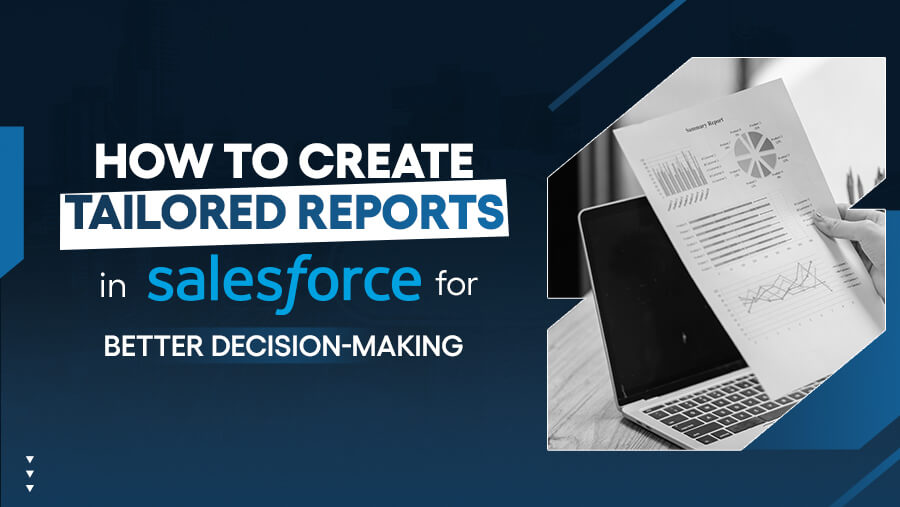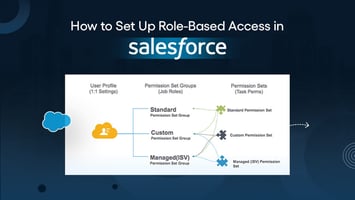
How to Create Tailored Reports in Salesforce for Better Decision-Making
Anisha

Are you spending hours sifting through Salesforce data without getting the necessary answers?
Tailored reports are your solution. They help you cut through the noise, focus on what truly matters, and confidently make data-driven decisions.
Whether tracking sales performance, analyzing customer trends, or monitoring pipeline health, customized reports ensure you have the insights needed to stay ahead.
Salesforce’s robust reporting features let you create reports as unique as your business. Customizing fields, filters, and visualizations allows you to align data with your goals and simplify decision-making.
Let’s explore how you can create tailored reports that empower smarter choices.
What Are Tailored Reports in Salesforce?
Tailored reports in Salesforce are custom-built reports designed to focus on specific data points that align with your unique business goals.
Unlike standard reports, which provide generic insights, tailored reports allow you to customize fields, filters, and visualizations to highlight the metrics that matter most to your organization.

Tailored reports are ideal for businesses that need actionable insights to make strategic decisions.
Use Cases for Tailored Reports
Here are some practical examples of how tailored reports can be used:

Tailored reports provide the clarity and depth needed to unlock your data’s full potential, enabling smarter decision-making and better business outcomes.
Benefits of Tailored Reports
Tailored reports in Salesforce provide immense value by addressing specific business needs. Here are the core benefits:
- Improved Decision-Making: Get precise and actionable insights to align with your goals.
- Time-Saving: Focus only on the data that matters, eliminating the need to sift through irrelevant details.
- Enhanced Collaboration: Share customized reports with teams to ensure everyone works with the same insights.
- Scalability: Modify and expand reports as your business grows and evolves.
Key Elements of a Tailored Report
You must customize its essential components to create a genuinely effective tailored report. Here's an overview of these elements:

By customizing these elements, you can transform your Salesforce reports into powerful tools for achieving better outcomes.
Step-by-Step Guide to Creating Tailored Reports
Here’s an overview of the process for creating a tailored report in Salesforce:

Now, let’s dive deeper into each step for a comprehensive understanding.
1. Choose the Right Report Type
To begin, navigate to the Reports tab in Salesforce. From there, you’ll need to select the correct report type based on your needs. Salesforce offers several types of reports, including:
- Tabular Reports: Simple data lists, ideal for quick views like contact lists.
- Summary Reports: Allows data grouping, which is useful for seeing trends within data sets.
- Matrix Reports: Used to compare related totals across both rows and columns, providing a more detailed view of data.
- Joined Reports: Combines multiple report types into one, suitable for complex data comparisons.
Choosing the right report type is crucial to ensuring your report displays data most effectively.
2. Set Filters
Filters help you narrow down your data to show only what’s relevant. For instance, you can set filters for:
- Date ranges (e.g., last quarter or last 12 months).
- User roles or regions (e.g., sales reps or territories).
- Opportunity stages (e.g., only opportunities in the 'Closed-Won' stage).
Apply these filters to refine the data your report will pull, ensuring you get only the information you need. Filters are essential for focusing your analysis and avoiding data overload.
3. Add Fields
Now that your report is filtered, you must add the fields you want to display. Salesforce makes this easy with a drag-and-drop interface:
- Select relevant fields from the field list (e.g., account names, sales amounts, or opportunity stages).
- Customize columns by dragging the fields into the report layout. This is where you decide which data points you want to highlight and show in your final report.
Only include fields that are directly relevant to the insights you’re seeking. Too many fields can clutter the report and make it harder to interpret the data.
4. Group and Summarize Data
Once your fields are set, it's time to organize the data to uncover meaningful trends. You can group data by categories, such as:
- Sales reps or account owners
- Product types or regions
- Opportunity stages or pipeline stages
Grouping your data this way helps you see patterns, such as which sales rep is performing best or which products generate the most revenue.
Additionally, you can use summary fields to calculate totals or averages (e.g., sum of sales by rep or average deal size by region).
5. Add Visual Elements
To make your report even more insightful, add visual elements like:
- Charts and graphs (e.g., bar charts, line graphs, or pie charts) to highlight trends and comparisons.
- Conditional formatting to highlight key data points or outliers (e.g., sales opportunities above a certain amount could be highlighted in green).
Visual elements help you grasp complex data quickly and present your insights in a more engaging way.
6. Save and Share
After creating your report, save it with a clear and relevant name for easy access later. Salesforce allows you to define sharing settings to control who can access the report. You can:
- Share it with individual users or specific teams (e.g., sales teams, managers).
- Set permissions to determine who can view, edit, or modify the report.
Sharing the right reports with the right people ensures everyone has the necessary data to make informed decisions.
By following these steps, you can create custom-tailored reports in Salesforce that provide the insights you need to make strategic decisions and drive business growth.
Best Practices for Tailored Reports
Creating effective, tailored reports in Salesforce can drive data-driven decision-making and help streamline workflows. Here are key best practices to ensure your reports are impactful and actionable:
Start with Clear Objectives
Before building any report, define the specific questions you want it to answer:
- Are you tracking sales performance?
- Are you analyzing customer behavior?
Setting clear objectives helps you design the report with the right data points and ensures it provides meaningful insights.
Keep It Simple
Focus on essential metrics that directly relate to your objectives. Avoid overloading your report with too many fields or data points, creating confusion. The more focused and straightforward your report, the easier it will be to analyze and decide based on it.
Leverage Filters and Groups
Use filters and groupings to break down your data into manageable segments. This allows you to drill down into the most relevant data.
For example, you can group your sales data by region or apply filters based on opportunity stages to see only what's crucial for your analysis.
Schedule Automatic Updates
Set up scheduled reports to run automatically and regularly send updated data to your team. This ensures everyone has timely access to fresh insights without manually generating reports every time. Automating reports for daily, weekly, or monthly insights increases efficiency and consistency.
Continuously Optimize
Review and refine your reports regularly. As business needs evolve, so should your reports. Gather user feedback and adapt the reports to ensure they continue delivering the most relevant information. Optimizing reports ensures they remain effective and aligned with your goals over time.
Examples of Tailored Reports for Better Decision-Making
Tailored reports are essential for focusing on specific business needs and driving informed decisions. Below are some common examples of tailored reports that can help you gain valuable insights across different areas of your business:

These examples illustrate how tailored reports can be used in various areas of your business, enabling you to make data-driven decisions with precision and clarity.
Conclusion
Tailored reports in Salesforce are powerful tools for making data-driven decisions that directly align with your business objectives. Customizing your reports allows you to access the most relevant data, improve efficiency, and enhance collaboration across teams.
Following the best practices outlined, from setting clear objectives to continuously optimizing your reports, ensures that the insights you gain will truly drive your business's growth and success.
News Letter
Subscribe our newsletter to get our
latest update & news


